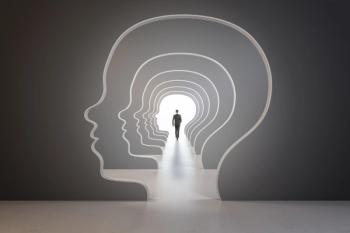
- Vol 40, Issue 4
Exploring the Biocognitive Model
Descartes said that if you want to know the mind, the only place to start was in the dissecting room.
CONVERSATIONS IN CRITICAL PSYCHIATRY
Series Editor Awais Aftab, MD
Niall (“Jock”) McLaren, MBBS, FRANZCP, is an Australian psychiatrist. He is honorary research fellow in the Department of Philosophy at University of Queensland. He recently retired after nearly half a century of practice, including 25 years in the far north of Australia. He has extensive experience in remote and military psychiatry and posttraumatic states. He has published extensively on the application of the philosophy of science to psychiatry, most recently with a formal integrative theory for psychiatry, the biocognitive model. He was previously interviewed as part of this series in Psychiatric Times® in
Aftab: Since your participation in this series in 2019, you have written and published your new book, Natural Dualism and Mental Disorder: The Biocognitive Model for Psychiatry.2 I am excited to have you back in the series to discuss the details of your model. Our earlier exchange gives the readers a fair idea of your discontents with contemporary psychiatry. Let’s begin with the notion of “natural dualism.” What do you mean by that and how does it differ from the more commonplace notion of “dualism” that many mental health professionals are familiar with?
McLaren: That is an important question to start with. Talking philosophy to a psychiatric audience is never easy, as too many psychiatrists seem to think that they are biological scientists, so it does not apply to their activities—but it does. Philosophy is simply the process of confronting and trying to answer complex questions, and what is more complex than the nature of mind and its disorders? Dualism is 1 attempt at answering the question of the nature of mind, but it gets a bad press these days, mainly due to misunderstanding. Dualism means 2-fold—that mind and body are not obviously the same. Richard Watson said, “The crux of dualism is an apparently unbridgeable gap between 2 incommensurable orders of being that must be reconciled if we (wish to justify) our assumption that there is a comprehensible universe.”3 That is neat because it also tells us there are 2 forms of causation. Historically, dualism relates to the French polymath, Rene Descartes (1596-1650), who said mind and body are composed of 2 different substances: the physical stuff of bodies and brains, and the mental stuff of the mind, each requiring nothing other than itself to exist. That leads to the problem of how those substances can possibly interact—the classic mind-body problem, of which he was perfectly well aware.
Natural dualism says “Yes, mind and body are profoundly different, with no properties in common, but mind arises from the brain by natural, law-like processes (laws of supervenience),” which we can probably understand. The idea is closely associated with philosopher David Chalmers, but very explicitly, there is no magic involved. My work takes it further and offers a biological mechanism by which a nonphysical mind supervenes upon or emerges from the physical brain. I have suggested what those laws are but, crucially, it uses processes that we have known about for a long time.
Aftab: You present a computational model of the mind as an informational space. What do you see as the boundaries of your notion of the “mind” here? When it comes to psychological processes such as memory and perception, which possess an essential neurobiological dimension, where does neurobiology end and information begin?
McLaren: This can be confusing because we are sentient beings; our entire perception of ourselves is based in this point. We are first and foremost information detectors, collectors, processors, storers, and transmitters. In the book, I derive a formal definition of information, but essentially, it is what we know and experience—what we can act on and communicate. That is the result of the brain doing its job as a very high-speed, multichannel information processor of ineffable complexity. The main boundary of the mind is that it is utterly private. My brain generates my mind and you cannot share it unless I use speech or action to convey a small part of it. The next boundary is that the sense of mind or consciousness the brain generates is completely dependent on the healthy brain. Even slight variations in physiology, such as a fever, can interfere with the natural process of generating the mind. We call that confusion or delirium. Physicians have to be very aware of it.
Descartes said that if you want to know the mind, the only place to start was in the dissecting room, and I totally agree. It is not possible to understand the concept of a mind emerging from the brain without a detailed knowledge of the brain and neurophysiological processes. This means, of course, that if the biocognitive model gets any traction, then the field of a nonmedical psychology will shrink dramatically. But it also means that the concept of a reductionist biological psychiatry is headed for the history books, replaced by a well-grounded mentalist psychiatry.
Aftab: In your model, how does the process become self-sustaining? Are there analogous ways in which information processing in a computer can be self-sustaining? Another prominent approach in psychiatry that emphasizes the self-sustaining nature of mental disorders is the network theory,4 which conceptualizes mental disorders as symptom networks where symptoms are causally related to each other (instead of being caused by a latent variable or a central disease process), and “If these causal relations are sufficiently strong, symptoms can generate a level of feedback that renders them self-sustaining.”4 It seems like there are different ways in which it is possible for us to theorize how psychiatric syndromes become self-sustaining.
McLaren: The process of mental disturbance becomes self-sustaining by a simple feedback loop more or less consistent with what Norbert Wiener described in 1948, the difference here being that part of the loop is cognitive—a matter of what the subject knows and believes. The arrow of causation loops between mental and physical. I have given several examples of how seeing or hearing something can generate an unpleasant mental state whose symptoms then cause the person to become more distressed. We see it myriad times a day in anticipatory anxiety, but it also applies to normal life.
For example, “Mr Smith” has to give a talk in front of his bosses. He is worried about how he will perform and his heart starts to beat a bit faster. But he believes a fast pulse means an impending heart attack so, as soon as he becomes aware of it, he becomes more agitated, which makes it beat faster. Before long, he is so agitated he has to cancel his presentation. The crucial factor is the cognitive element—that the patient must fear his own symptoms. I have also emphasized the challenge hypothesis and its role in dominance hierarchies, and how the drive to dominance produces its own instability. This is important, not just in psychiatry, but also in social and political life.
Network theory, on the other hand, seems to be deficient in that it does not involve this crucial cognitive factor. The concept uses the recursive properties of networks but inserts symptoms as the nodes, not giving credit to the notion that symptoms do not exist in isolation—that they exist separate from the mind. They are part of a much larger mental state of which the subject’s knowledge state is an integral part. Because network theory is not part of a larger theory of mind, it treats the human as an automaton, not a sentient being. I am not much convinced by these highly abstract theories in cognitive sciences.
Aftab: How does your model account for the presence of neurobiological risk factors (such as genetics, HPA axis, inflammation, neurotrophic factors) that influence the probability of experiencing various mental disorders? How do psychoactive substances and biological interventions successfully change the informational content?
McLaren: Mental disorder is the overt or experienced manifestation of some disturbance in the brain-mind complex. Remember that when something goes wrong in an informational model, there are 2 aspects to consider: (1) the physical, meaning the brain, and (2) the informational or mental. The initial physical state of the brain is determined by the genome; the most extensive studies so far have failed to find any significant genetic contribution to any single mental disorder. At best, there is a genetic tendency to mental disorder which, as I argued in the
All of this is mediated by chemicals except the chemicals are under direct mental control. The mental perception is the first event in a long causal chain. That is directly opposite to what reductionist biological psychiatry says and explains why they cannot find any primary physical causes to mental disorder. There really are not any. But until now, psychiatry has not had a model of mind tailored to its needs, so they tried to write the mind out of the equation.
Aftab: You have said that the biocognitive model offers “a genuinely bio-psycho-social model.” What makes this model bio-psycho-social?
McLaren: It is biological in that it says you cannot even begin to work out why the human mind is as it is without considering the “wetware” of the entire central nervous system (CNS) and the rest of the body, of course. It is psychological, as it says the mind runs the brain, not the other way around, and it shows just how the mind-body problem is to be approached so that a resolution falls into place. With a formal mentalist theory of mind, firmly grounded in the physical structure and function of the brain, we can integrate social factors into the calculation instead of paying lip service as DSM does. What you believe becomes instrumental in determining how you behave and how you feel, which solves the determinism question: Yes, we most definitely do have free will, but, as
The problem is what has been called “the great 20th century prejudice” of insisting that mentalist constructs are necessarily supernatural. This has led to so many dead-ends, biological reductionism, behaviorism, functionalism—the list goes on. We humans have mental capabilities. The problem for science is to give account to them, not write them out of the equation.
Aftab: Since you do accept that considering the “wetware” of the CNS is essential, what sort of neuroscientific research do you think it makes more sense for psychiatric researchers to pursue?
McLaren: The first thing for any psychiatric researcher is to work out what psychiatrists should be studying, meaning they have to write their model of mental disorder. There cannot be a research program without a model of the field; that is not science. We do not need to be doing any “neuroscientific research.” We need a consensus on the nature of mental disorder and the best way of approaching it. For example, look at the vast sums of money spent on genomic research with, even its most ardent supporters would agree, skimpy results that have never influenced treatment in any way. But who proved that mental disorder has a genetic basis? Nobody—it was just assumed as an article of faith. You might not remember the “biogenic amines in the hypothalamus” story or taraxein or minimal brain damage; the research preceded the elementary process of working out whether these things were possible. It was only when the research failed that people wondered if it ever had a chance, but by then they had moved on to the next fad.
That is what the biocognitive model is about: Here is an articulated model that starts with first principles and builds a structure that can be tested. It says, “The great bulk of ordinary mental disorder is wholly psychological with no underlying brain disorder.” It does not actually need much basic research; we can comfortably ride on other researchers’ work. But regardless, the model has to come before any research program is written. The model dictates the research program, and psychiatry has never done that.
Aftab: In cognitive sciences, we have seen a shift toward what are called the 4E approaches according to which mental processes are embodied, embedded, enacted, and extended.7 The 4E approaches are skeptical that cognition can be described fully in terms of abstract processes such as computations and representations and argue that we must refer to bodily mechanisms and active interactions between the organism and the environment when talking about cognition. Do you see any incompatibility between your computational view of the mind and the 4E approaches?
McLaren: I was restricted to 70,000 words, so there are lots of topics I did not mention, and bringing in too many esoteric subjects is a great way of losing your readership. I have not read that particular book, and while there are lots of books I have not read, my impression is that my work is entirely consistent with their approach. I have always said that if a model of mind does not generate a model of mental disorder, it is not worth the paper it is printed on. The available models of mind, and I do not want to sound as though I am picking on him, but Dennett’s functionalism is a good example: It does not lead to a model of mental disorder. We can discard all those models. But the embodied cognition model—yes, I am 110% on the same side as they are. What did you say? “We must refer to bodily mechanisms and active interactions between the organism and the environment when talking about cognition.” Yes. Totally agree. I have just written a book about that. That means for the first time in its history, psychiatry is right up with the latest trend in philosophy.
And there is another book illustrating this point due out at the end of this year. Last year, I was feeling a bit tired of psychiatry, so I decided to apply the biocognitive model to a different field, 1 that interests me: politics. Specifically, I looked at the question of ultra–right-wing extremism, aka fascism. The biocognitive model gives a novel view of this crucial topic, but it is not “psychiatry unlimited” because it concludes, “These people are not mentally ill.” It is a growing field, and it all goes back to dualism. Descartes was on the right track after all. Thanks for your questions. It is an interesting field.
Aftab: Thank you!
Dr Aftab is a psychiatrist in Cleveland, Ohio, and clinical assistant professor of psychiatry at Case Western Reserve University. He leads the interview series
Dr Aftab and Dr McLaren have no relevant financial disclosures or conflicts of interest.
References
1. Aftab A. Chaos theory with a human face: extended version. Psychiatric Times. October 28, 2019.
2. McLaren N. Natural Dualism and Mental Disorder: The Biocognitive Model for Psychiatry. Routledge; 2021.
3. Watson RA. In: Audi R, ed. The Cambridge Dictionary of Philosophy. University Press; 1995.
4. Borsboom D.
5. McLaren N. Anxiety - The Inside Story: How Biological Psychiatry Got it Wrong. Future Psychiatry Press; 2018.
6. Kahneman D. Thinking, Fast and Slow. Penguin Press; 2012.
7. Gallagher S, de Bruin L, Newen A, eds. The Oxford Handbook of 4E Cognition. OUP Oxford; 2018.
Articles in this issue
over 2 years ago
The Border Zone Between bvFTD and Primary Psychiatric Disordersover 2 years ago
A Case of Clozapine and Cancerover 2 years ago
On the Convergence of Science and Clinical Practiceover 2 years ago
Role of Lithium in 2023 in Bipolar I Mania and Depressionover 2 years ago
Professional Courtesy: Guidelines for Physiciansover 2 years ago
Toolsover 2 years ago
Co-occurring Substance Use and Eating Disordersover 2 years ago
Yes, It’s All in Your HeadNewsletter
Receive trusted psychiatric news, expert analysis, and clinical insights — subscribe today to support your practice and your patients.

















